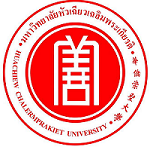Please use this identifier to cite or link to this item:
https://has.hcu.ac.th/jspui/handle/123456789/3418Full metadata record
| DC Field | Value | Language |
|---|---|---|
| dc.contributor.author | ชุติระ ระบอบ | - |
| dc.contributor.author | อดุลย์ นงภา | - |
| dc.contributor.author | สุชาติ วัฒกานนท์ | - |
| dc.contributor.author | มรกต กำแพงเพชร | - |
| dc.contributor.author | สุพิศพรรณ วัจนเทพินทร์ | - |
| dc.contributor.author | Chutira Rabob | - |
| dc.contributor.author | Adul Nongpa | - |
| dc.contributor.author | Suchart Wattaganon | - |
| dc.contributor.author | Morakhot Kamphaengphet | - |
| dc.contributor.author | Supisphun Watjanatephin | - |
| dc.contributor.other | Huachiew Chalermprakiet University. Faculty of Business Administration | en |
| dc.contributor.other | Huachiew Chalermprakiet University. Faculty of Business Administration | en |
| dc.contributor.other | Huachiew Chalermprakiet University. Faculty of Business Administration | en |
| dc.contributor.other | Huachiew Chalermprakiet University. Faculty of Business Administration | en |
| dc.contributor.other | Huachiew Chalermprakiet University. Faculty of Business Administration | en |
| dc.date.accessioned | 2024-12-30T08:17:48Z | - |
| dc.date.available | 2024-12-30T08:17:48Z | - |
| dc.date.issued | 2017 | - |
| dc.identifier.citation | วารสาร ธุรกิจปริทัศน์ 9, 2 (กรกฎาคม - ธันวาคม 2560) : 123-140. | en |
| dc.identifier.uri | https://has.hcu.ac.th/jspui/handle/123456789/3418 | - |
| dc.description | สามารถเข้าถึงบทความฉบับเต็ม (Full text) ได้ที่ : https://so01.tci-thaijo.org/index.php/bahcuojs/article/view/117850/90409 | en |
| dc.description.abstract | โครงการวิจัยประเมินหลักสูตร มีวัตถุประสงค์เพื่อประเมินคุณภาพการจัดการศึกษาหลักสูตรบริหารธุรกิจบัณฑิต สาขาวิชาธุรกิจจีน คณะบริหารธุรกิจ มหาวิทยาลัยหัวเฉียวเฉลิมพระเกียรติ (หลักสูตรใหม่ 2554) โดยใช้ตัวแบบ CIPP Model ของ Daniel L. Stufflebeam เป็นการประเมินทั้งด้านบริบท ปัจจัยนำเข้า กระบวนการ และผลผลิต ประชากร ได้แก่ ผู้เรียนหรือนักศึกษาที่กำลังศึกษาอยู่ บัณฑิตที่สำเร็จการศึกษา อาจารย์ผู้สอนประจำหลักสูตรและอาจารย์พิเศษ นายจ้างหรือผู้บังคับบัญชาของบัณฑิต เครื่องมือวิจัย ได้แก่ แบบสอบถามและแบบสัมภาษณ์ การวิเคราะห์ข้อมูลโดยใช้สถิติอย่างง่ายในรูปความถี่ ร้อยละ ค่าเฉลี่ย ค่าส่วนเบี่ยงเบนมาตรฐาน และใช้การวิเคราะห์เชิงพรรณนาผลการวิเคราะห์ข้อมูลปัจจัยในแต่ละด้านพบว่า ปัจจัยที่มีคะแนนเฉลี่ยสูงสุดมีดังนี้ ด้านบริบท ได้แก่ โครงสร้างหลักสูตรและรายวิชา ความเหมาะสมของจำนวนหน่วยกิตรวมตลอดหลักสูตร มีการเรียงลำดับรายวิชาต่างๆ ในแต่ละชั้นปีเหมาะสม เนื้อหาในรายวิชาตรงตามวัตถุประสงค์ของหลักสูตร เนื้อหาแต่ละรายวิชาไม่ซ้ำซ้อนกัน และวิชาเอกเลือกมีจำนวนหน่วยกิตที่เหมาะสม ด้านปัจจัยนำเข้า ผู้เรียน มีทัศนคติที่ดีต่อสาขาวิชา ผู้สอนเป็นแบบอย่างที่ดีในด้านวิชาชีพ ด้านกระบวนการ มีการกำหนดวัตถุประสงค์ ขอบเขต กิจกรรมการเรียนการสอน และการประเมินผลที่ชัดเจน กระตุ้นและเปิดโอกาสให้ผู้เรียนแสดงความคิดเห็นอย่างเต็มที่ในชั้นเรียน ระยะเวลาในการเรียนการสอนแต่ละวิชามีความเหมาะสม และส่งเสริม ให้ผู้เรียนมีการใช้เทคโนโลยีอินเทอร์เน็ตประกอบการเรียน ด้านประสิทธิภาพการบริหารหลักสูตร กิจกรรมเสริมหลักสูตรมีหลากหลาย ด้านผลผลิต ได้แก่ มีความรู้ในสาขาวิชาที่สำเร็จการศึกษาอย่างลึกซึ้ง ความรู้ในสาขาวิชาอื่นที่เป็นประโยชน์ต่อการปฏิบัติงาน การใช้เทคนิค เครื่องมือ และวิธีการวิเคราะห์และแก้ปัญหา ด้านจิตพิสัย มีความคิดริเริ่มสร้างสรรค์ เสียสละและอุทิศตนในการทำงาน ด้านทักษะ ทำงานโดยยึดวัตถุประสงค์และเป้าหมายขององค์การ ปัญหาของหลักสูตรคือความแตกต่างในพื้นฐานความรู้ภาษาจีนของนักศึกษาแรกเข้า สำหรับข้อเสนอแนะจากผลการวิจัยประเมินหลักสูตรคือ ควรเน้นความรู้เฉพาะด้านและสร้างเครือข่ายความร่วมมือกับหน่วยงานที่เกี่ยวข้อง | en |
| dc.description.abstract | This research aimed to evaluate the quality management in education of the Bachelor Degree Program in Business Administration (Chinese Business) (New Curriculum 2011). The evaluative research was based on the Daniel L. Stufflebeam CIPP Model comprised of context, input, process and output, the population included stakeholder such as current students, graduates, employers and lecturers. The research instrument’s were questionnaires, interviews and focus group by using simple statistics : frequency, percentage, average, standard deviation and descriptive data analyzed. The results of this research represented the maximum scored average in each factors of this model which consist of 1) Context : credits were appropriate, the suitable of the subjects priority, subject matter were in accordance with the curriculum, not complicate in each subject matters and sufficiency in selected subjects. 2) Input : were the good attitude’s learner and the lecturer have code of ethics in career. 3) Process : the objectives, scope, activities and หกevaluation be clear, it has the impulse and let learner to have suggestion in class, the appropriate of the period of time and promote learners to get used to internet technology. The curriculum have different activities. 4) Output : the graduates have profound knowledge in program, include another knowledge in others subject for work. Besides graduates have efficiency in techniques and problem solving method. For affective domain graduate have creative mind, sacrifice and dedication. For skill, they abide by organization’s objectives and goals. The differential fundamental knowledge in Chinese language is the problem of first year students. The research suggestion was the curriculum should focus area of study in Chinese business and strengthening of cooperation connectivity with related partnerships | en |
| dc.language.iso | th | en |
| dc.subject | การประเมินหลักสูตร | en |
| dc.subject | Curriculum evaluation | en |
| dc.subject | การบริหารธุรกิจ -- หลักสูตร | en |
| dc.subject | Business administration -- Curricula | en |
| dc.subject | การบริหารธุรกิจ -- การศึกษาและการสอน | en |
| dc.subject | Business administration -- Study and teaching | en |
| dc.title | วิจัยประเมินหลักสูตรบริหารธุรกิจบัณฑิต สาขาวิชาธุรกิจจีน (หลักสูตรใหม่ 2554) คณะบริหารธุรกิจ มหาวิทยาลัยหัวเฉียวเฉลิมพระเกียรติ | en |
| dc.title.alternative | The Evaluation Research of Bachelor Degree Program in Business Administration Chinese Business (New Curriculum 2011) Business Administration Faculty Huachiew Chalermprakiet University | en |
| dc.type | Article | en |
| Appears in Collections: | Business Administration - Articles Journals | |
Files in This Item:
| File | Description | Size | Format | |
|---|---|---|---|---|
| Evaluation-Research-of-Bachelor-Degree-Program-in-Business-Administration-Chinese-Business.pdf | 105.37 kB | Adobe PDF | View/Open |
Items in DSpace are protected by copyright, with all rights reserved, unless otherwise indicated.
